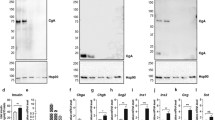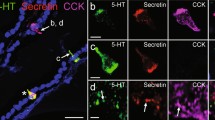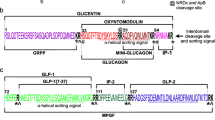Abstract
Enterochromaffin-like (ECL) cells regulate gastric acid secretion through vesicular release of histamine. Until now, the molecular machinery of human ECL cells involved in the formation and release of vesicles is largely unknown. We analyzed tissue samples obtained from normal human gastric mucosa (n=4) and ECLomas (n=5) immunohistochemically using the APAAP method or double immunofluorescence confocal laser microscopy. Human pheochromocytomas (n=5) were investigated in parallel and compared to ECL cells. Secretory pathways were characterized using antibodies specific for marker proteins of large dense-core vesicles (LDCVs; islet cell antigen 512, chromogranin A, pancreastatin, and vesicular monoamine transporter 2) and small synaptic vesicle (SSV) analogues (synaptophysin). Tissues were also analyzed for expression of the peptide hormone processing enzymes, carboxypeptidase E and prohormone convertase 1, as well as the soluble N-ethylmaleimide-sensitive factor attachment protein receptor (SNARE) proteins, 25-kDa synaptosome-associated protein (SNAP25), syntaxin, and synaptobrevin. Immunoreactivity for markers of LDCVs and SSV analogues were detected in normal ECL cells and ECLomas. Both tissues also showed expression of carboxypeptidase E and prohormone convertase 1. Analysis of vesicular SNARE (v-SNARE) and target membrane SNARE (t-SNARE) proteins revealed the presence of SNAP25, syntaxin, and synaptobrevin in normal and neoplastic ECL cells. Our data suggest that ECL cells possess the two vesicle types of regulated neuroendocrine secretory pathways, LDCVs and SSV analogues. Since ECL cells also contain typical SNARE proteins, the molecular machinery underlying secretory processes in this cell type appears to be identical to the secretory apparatus of neuroendocrine cells and neurons. In addition, our findings suggest that the secretory apparatus of ECL cells is maintained during neoplastic transformation.
Similar content being viewed by others
Author information
Authors and Affiliations
Additional information
Accepted: 10 June 1999
Rights and permissions
About this article
Cite this article
Höcker, M., John, M., Anagnostopoulos, J. et al. Molecular dissection of regulated secretory pathways in human gastric enterochromaffin-like cells: an immunohistochemical analysis. Histochemistry 112, 205–214 (1999). https://doi.org/10.1007/s004180050408
Issue Date:
DOI: https://doi.org/10.1007/s004180050408




